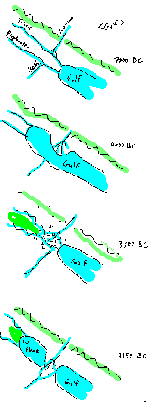
Dear Cessair
Thanks for the information from the Woolley excavations, the logs of borings and test shafts provide exactly the information I needed to create the stratigraphic events at the time of "The Flood." You will see it fits very nicely with Woolley's suggestion that there was a major identifiable flood event at about 3000 to 5000 BC. It has sometimes been suggested that Woolley "created" this story for popular consumption but if what follows can be proven out then .... well, we'll see what, then.
What we find consistently for many miles around Ur and Uruk is an
old swamp surface at a depth of 15 ft. below the current vast marsh area
(that same area that has played such an important part in recent events
in Iraq!). Archaeologically this level corresponds to the al-Ubaid culture
of painted pottery and pre-Dynastic Uruk. My geologic section shows this
to be the "pre flood surface." 
This is overlain by Woolley's flood sand layer which shows up distinctively in several shafts. The sand is apparently massively bedded, i.e. deposited all at once. But how could such a great thickness of sand be deposited in one event?
The answer is that a substantial deep lake must have formed quickly and remained in place for some time, all in accordance with the biblical story. Of course that lake only covered the lower Tigris and Euphrates valley but this may justifiably and metaphorically be called "the whole world" by the Sumerian storyteller, just as "forty days" may be (and was) taken metaphorically to be "a long time." Moreover, we can see from the extensive paleoclimatological data we have collected that the climatic oscillation which broke the warm "Atlantic" era was in fact world wide; hence, similar events would have occurred in all river valleys, so that the flood can indeed be said to be universal.
The question remains, how was this particular flood created in Mesopotamia?
The answer is that the flood did not arise from any remarkable event on the Tigris or Euphrates, but on the Karun River, which joins and partially blocks the lower valley at what is now al Basra (appropriately enough the site of the Tales from the Arabian Nights!)). From time to time when flows are exceptional or the behavior of the river is disturbed the Karun must switch delta channels and flow up valley. If the lower valley is blocked by fresh sediment from the Karun delta a huge lake will form in the marshy area, remaining there at least "forty days" until it re-erodes a channel back through what is now the Shatt al-Arab. (The dry Wadi al Batin, draining from the south, forms the fourth of the rivers of the Garden of Eden.)
 Hence as I show on the sketch
it is flooding on the Karun that caused "the flood," wiping out
the known cultures in the lower valley. The process has an identical geomorphology
(and perhaps morality?) to the formation of the Salton
Sea above the Gulf of California, with the Colorado River playing the
part of the Karun. What, then, remains to prove the date of the event?
The answer is in two parts:
Hence as I show on the sketch
it is flooding on the Karun that caused "the flood," wiping out
the known cultures in the lower valley. The process has an identical geomorphology
(and perhaps morality?) to the formation of the Salton
Sea above the Gulf of California, with the Colorado River playing the
part of the Karun. What, then, remains to prove the date of the event?
The answer is in two parts:
1. Proof in Mesopotamia; and
2. Universal proof.
The answer to the first is straightforward, and I am hoping that my visit to the museum tommorrow will give us what we need.
The second proof is actually even more interesting, and I hope we can discuss that when we get together next month!
Love, Dick
Copyright 1996 Kirribili Press. Return to Ignatius Donnelly and the End of the World | Love | Chronicle of the Late Holocene